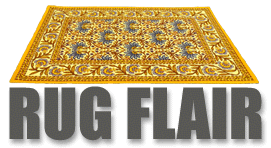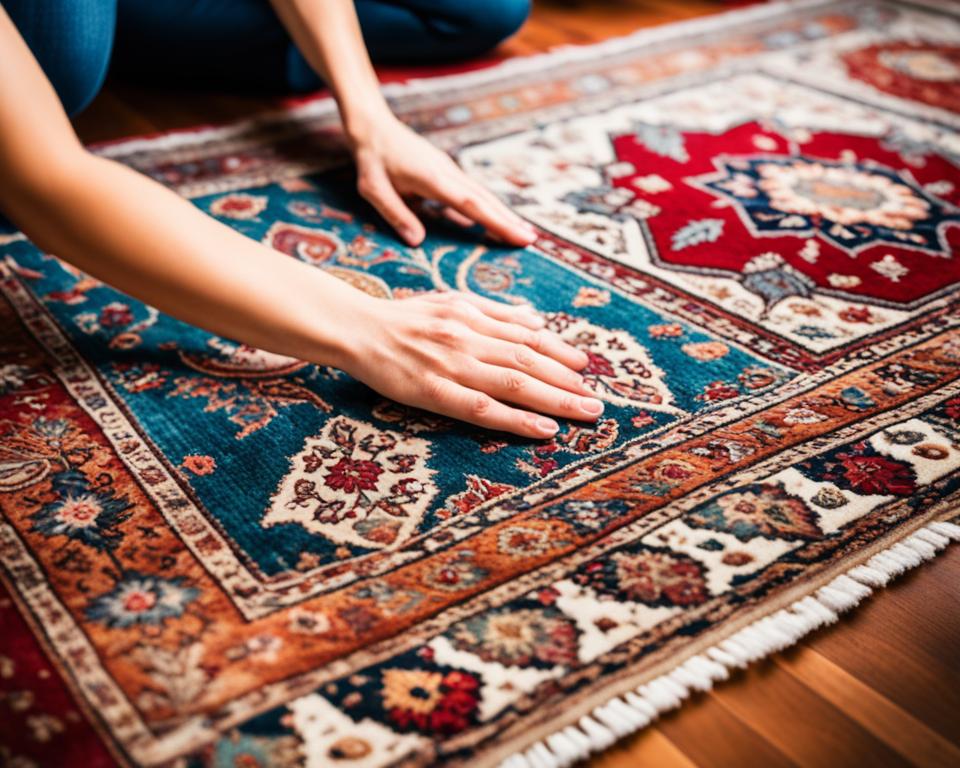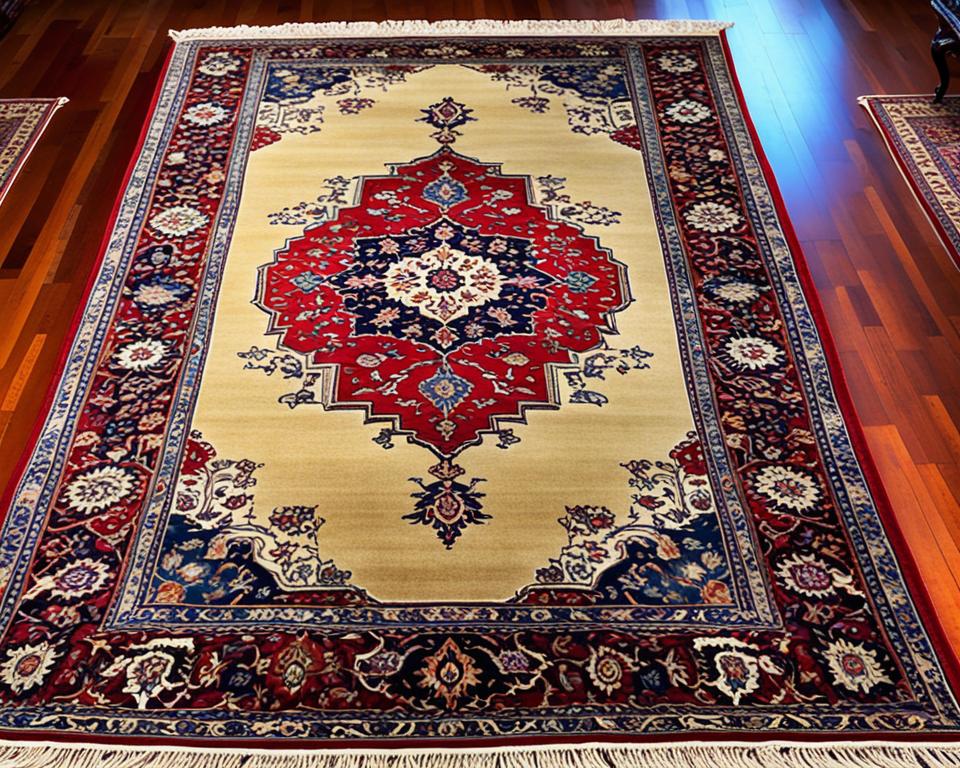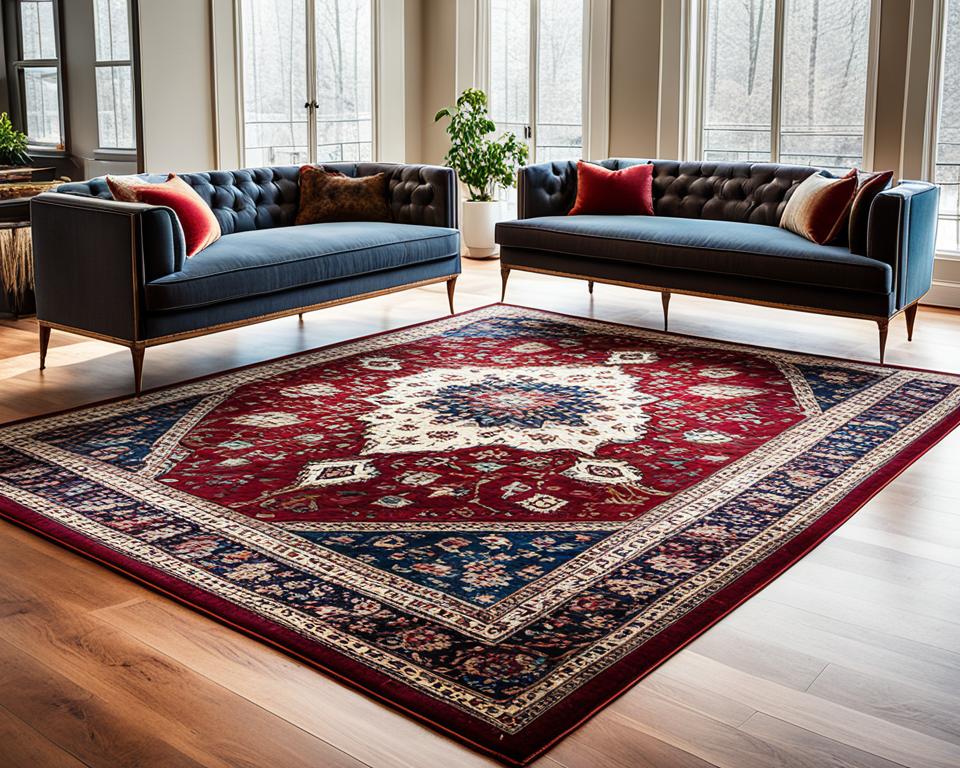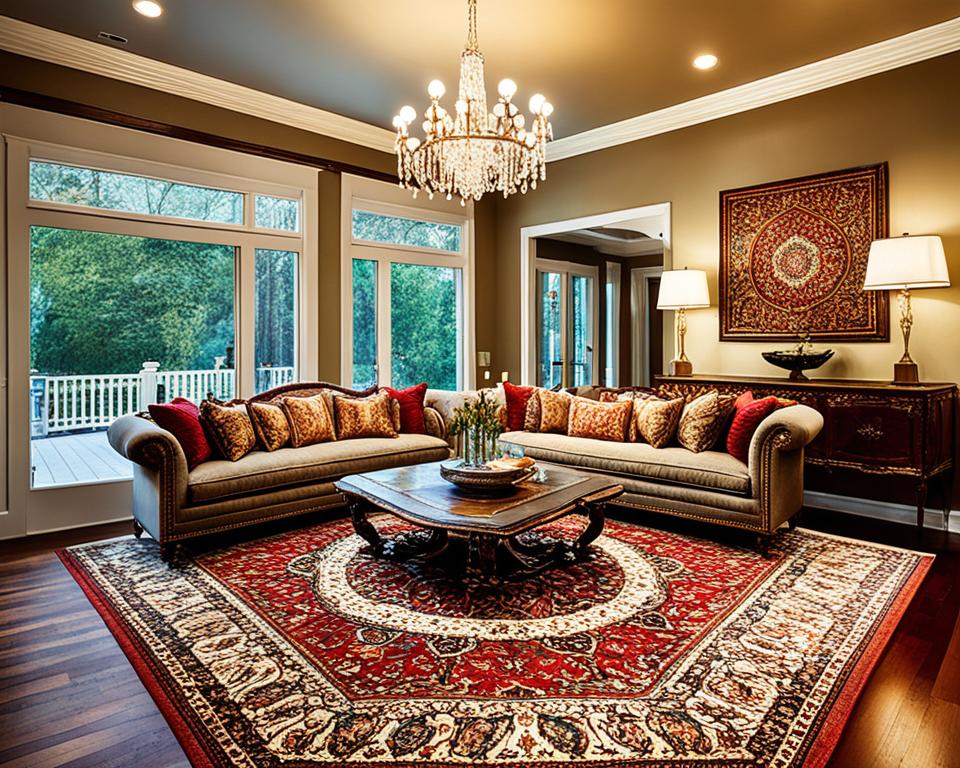Welcome to the cherished domain of Persian rugs—a realm where the elegant past meets modern luxury in every weave. If you’re on a quest to elevate your living space with timeless sophistication, deciphering the world of Persian carpets reviews is your first step to claiming this opulent treasure. Whether it’s the majestic designs of best Persian rugs that enchant you or the cultural richness of authentic Persian rug brands you seek to unfurl in your home, this guide is your trusted companion.
Your journey towards acquiring a handcrafted marvel—be it for draping your floors or as an heirloom piece—requires a discerning eye. The wisdom within handmade Persian rug reviews and the sharpness of a Persian rug comparison are your allies. Unlock the secrets of prime craftsmanship, discover which top Persian rug brands resonate with your aesthetic, and gain invaluable Persian rug buying tips to ensure your selection not only adorns your abode but also tells a story as rich and profound as the history woven into its threads.
As you embark on this cultural sojourn, remember that you are not just acquiring a rug but a slice of Persian artistry. So, let this authentic Persian rug guide illuminate the path to your perfect purchase.
Key Takeaways
- Unearth the finest Persian rug ratings to make an educated choice for your home decor.
- Identify the hallmarks of the best Persian rugs, from knot count to natural dyes.
- Align your tastes with the legacy of Top Persian rug brands known for their exceptional quality.
- Garner essential Persian rug buying tips to spot authentic craftsmanship amidst the myriad of options.
- Utilize an authentic Persian rug guide to differentiate between genuine and imitation pieces.
- Consult handmade Persian rug reviews for first-hand experiences and recommendations.
- Understand the importance of Persian rug comparisons for an investment that appreciates over time.
The Art of Identifying Authentic Persian Rugs
Embark on the enlightening path of discovering an authentic Persian rug. This Authentic Persian rug guide will provide you with the cardinal elements that affirm the genuine quality and heritage of these exquisite textiles. As you delve into this world, let’s uncover the nuanced details that mark the difference between an ordinary rug and a true Persian masterpiece.
The Significance of Knot Count
The very soul of a Persian rug lies in its knot count, a crucial marker for assessing its craftsmanship. When conducting your Persian Rug Review, a meticulously handwoven rug will boast a knot count of at least 120 knots per square inch, a testament to the weaver’s dedication. As you flip over an esteemed Tabriz or Nain, let your fingertips feel the tell-tale signs of authenticity—the irregularities and the larger knots that only the hands of a master can create.
Materials Tell a Story: Wool, Silk, and Cotton
An authentic Persian rug narrates its origins through the materials used. Wool, a symbol of durability and comfort, is traditionally the most common fabric. Silk, however, speaks of opulence, enhancing the definition and intricacy of each design, and thus often found in the most luxurious of rugs. Cotton, meanwhile, offers robustness to the foundation. Understand that each material offers not just a tactile experience but a window into the rug’s journey from concept to creation.
Natural vs Synthetic Dyes: The Color Test
The color of your Persian rug whispers secrets about its age and origin. As part of Persian rug comparison, observe the shades closely. Authentic pieces will charm you with the depth and vibrancy that only natural dyes can impart—uneven yet full of character. In contrast, synthetic dyes will seem overly uniform and lackluster. This subtle art of dyeing is not just a process but a celebration of nature’s palette, as practiced by generations of skilled artisans.
As you advance in your search for the perfect Persian rug, integrate these Persian rug buying tips and trust your senses. Let the knowledge of knot counts, materials, and dyes empower you to discern with confidence. May your Persian rug not only adorn your home but also bring a fragment of Persian heritage into your everyday life.
Understanding Persian Rug Designs and Patterns
As you navigate the historic pathways of Persian rug manufacture, understanding the complex tapestry of designs and patterns is essential. These motifs are more than mere decor; they are steeped in symbolism and the traditions of the Iranian artisans who have crafted them for centuries. Diving into the intricacies of these designs will enhance your insight into what makes the best Persian rugs not merely a floor covering, but a narrative woven in knots and colors. This understanding is invaluable, particularly when considering Persian carpets reviews or pondering Persian rug ratings for your collection.
Floral, Geometric, and Paisley: Decoding Symbolism
Persian rugs often feature a mesmerizing combination of floral, geometric, and paisley patterns, each conveying its own unique symbolism. Floral designs typically celebrate the beauty of nature and signify life and abundance. Geometric patterns, with their orderly arrangements, are symbolic of structure, stability, and the harmonious balance of the universe. The iconic paisley motif, with its droplet shape, often represents the essence of life and eternity, showing how deeply connected Persian rug artisans are to the philosophical questions of existence.
Regional Variances in Iranian Rugs
Adding to the tapestry of Persian rug patterns are the regional variances that highlight the unique identities and histories of different areas within Iran. For instance, Tabriz, an esteemed carpet weaving center, is renowned for its diverse spectrum of designs that often carry historical narratives and local folklore within their weaves. It’s important to recognize these regional differences, as they not only contribute to the rug’s beauty but also to its cultural significance, making each rug a distinct piece of art.
- Floral Motifs: Symbolize life, bringing vibrant aesthetics and philosophical depth.
- Geometric Patterns: Represent order and harmony, serving as a visual anchor in design.
- Paisley: Iconic for its life-affirming shape, captures the essence of eternity.
Whether you’re an enthusiast reading detailed Persian carpets reviews, a decorator searching for the best Persian rugs to enhance your space, or a collector discerning the subtle nuances that affect Persian rug ratings, the key is in the details of the design. Let the patterns tell their story and guide you to the perfect Persian treasure.
Persian Rug Review: Tabriz Rugs and Their Legacy
When exploring the illustrious world of Top Persian rug brands, the exquisite artistry of Tabriz rugs often captures the hearts of connoisseurs and design aficionados alike. Originating from one of Iran’s premier carpet-weaving cities, Tabriz rugs are a pinnacle of quality, boasting some of the Best Persian rugs available today. Their legacy stretches over centuries, characterized by high knot density and an expansive array of sophisticated designs.
In your quest to select a rug that resonates with a traditional yet opulent essence, becoming familiar with the distinctive features of Tabriz rugs is paramount. Revered for their Persian rug ratings, these carpets offer a luxurious appeal that transcends borders, enchanting homes around the globe with their time-honored elegance.
Tabriz rugs epitomize the merging of art and history, a harmonious blend that speaks of Iran’s rich cultural heritage.
Imagine the sumptuous feel and visual splendor of a Tabriz rug underfoot, adorned with intricate teardrop medallions or depicting scenes of historical significance that seem to narrate tales from ancient times. The flourishing floral motifs and the iconic “Mahi” pattern, resembling a fish throughout the design, signify a grandeur that is both unique and remarkably versatile.
The exquisite nature of these rugs is not accidental but the fruit of a labor-intensive process, where artisans imbue each carpet with months, if not years, of skilled labor. This is the art that defines the soul of Tabriz rugs:
| Feature | Significance |
|---|---|
| Knot Density | Indicative of fine craftsmanship and durability |
| Design Complexity | Translates to visual intrigue and storytelling depth |
| Material Quality | Synonymous with luxury and adorned for longevity |
| Cultural Heritage | Reflects Iran’s historical artistry and weaving techniques |
For those who hold design and craftsmanship in high esteem, Tabriz rugs are a testament to a regal tradition that continues to thrive and evolve. Whether it graces a minimalist modern household or an opulent classical setting, a Tabriz rug is not just an addition to your decor—it is a statement of discerning taste.
As you weigh the options among Top Persian rug brands, remember the legacy of Tabriz. It’s more than just aesthetics; it’s a touch of history, an heirloom to treasure, and an investment to appreciate over time. With a Tabriz rug, you secure not merely a design element but a saga of artistry that will continue to enchant for generations to come.
- Consider high knot counts indicative of premium Tabriz offerings.
- Seek out the renowned “Mahi” pattern for a distinctive Tabriz accent.
- Trust in Tabriz to deliver a rug that rates highly in both beauty and resilience.
Let your home tell its own story with a piece of Persia, chosen from among the Best Persian rugs in the world. As you sit back and admire your Tabriz rug, indulge in the thought that you own a masterpiece that is steeped in an opulence that only the finest of Persian rugs can provide.
How Persian Rug Construction Defines Authenticity
Understanding the intricate craftsmanship behind a Persian rug is fundamental in distinguishing an authentic piece from the plethora of replicas on the market. As you dive into the Authentic Persian rug guide, you’ll discover that the essence of an original Persian rug is deeply ingrained in its construction. A crucial aspect to examine is the hand-knotting process, which is a true testament to the rug’s legitimacy and inherent value.
Hand-Knotted Excellence
When considering Persian rug buying tips, recognizing the value of a hand-knotted rug ranks highly. Each knot is carefully tied by skilled artisans, with their expertise reflected in the dense and intricate pattern work. This time-honored technique takes years to master and months or even years to create just one rug, symbolizing a legacy passed down through generations. Authentic hand-knotted Persian rugs tell a rich historical narrative, seen and felt in every fiber.
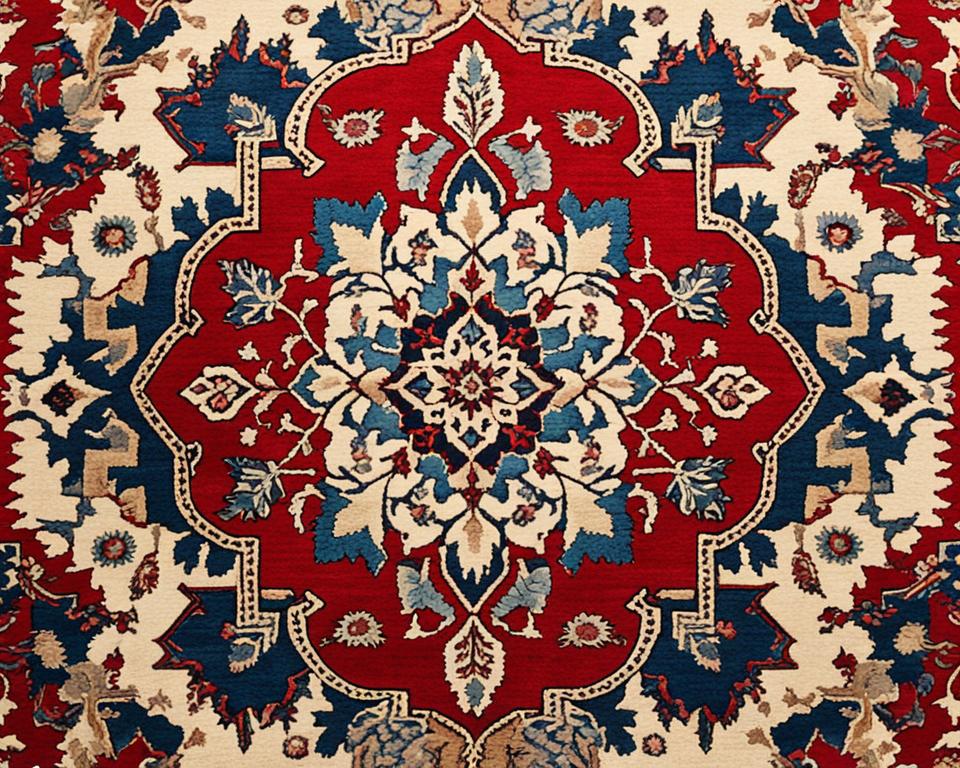
These masterpieces boast a level of detail and quality that machine-made rugs simply cannot replicate. The individuality of a hand-knotted rug can be found in the variable knot size and the unique design intricacies that a machine’s uniformity lacks. When weighing your options, a genuine hand-knotted rug stands as a premium choice within Handmade Persian rug reviews.
Examining Rug Backings for Clues
Turning a rug over can reveal as much about its authenticity as admiring its face. The bottom of a Persian rug holds the keys to its true origin. On an authentic rug, the knots and the weft and warp threads should be visible, potentially irregular but full of character. Such inconsistencies are distinctive signs of handcrafting, each telling a story through the motif visible on the flip side.
Machine-made rugs present a stark contrast, characterized by their uniform and rigid backs. These backings are typically made of synthetic materials, often covered by a stiff plastic layer to keep the rug together. This plastic feel underfoot is a clear indicator of a non-authentic rug—a detail to keep in mind from your Persian rug buying tips. Authentic Persian rugs, on the other hand, have a soft backing, allowing the rug to lie flush and mold with the floors of your home.
As you embark on finding your own piece of Persian heritage, let these insights from Authentic Persian rug guides steer your decision. Feel the texture, inspect the knots, and remember that each genuine Persian rug embodies a story crafted one knot at a time. Whether seeking daily luxury underfoot or a revered collectible, the choice of a hand-knotted Persian rug is an investment in beauty, tradition, and artistry.
Persian Rug Ratings: Factors You Should Consider
When delving into the world of Persian carpets reviews, understanding the nuanced factors that contribute to Persian rug ratings is essential. A blend of aesthetic appeal, durability, and cultural significance dictate the value and desirability of these artisanal creations. Below, we navigate through the qualities that traverse beyond the surface to ensure you’re well-equipped for a Persian rug comparison.
Material Quality and Texture
One of the foremost aspects that experts and enthusiasts consider in Persian rug ratings is the material quality and texture. Hand-spun wool, frequently found in Persian rugs, is lauded for its durability, comfort, and hypoallergenic properties, catering to an authentic experience and longevity. On the luxurious end, silk’s fineness imparts a sumptuous texture and sheen that elevates the intricacy of the rug’s design, engendering a profound visual and tactile pleasure.
| Material | Attributes | Benefits |
|---|---|---|
| Wool | Soft, Durable | Longevity, Comfort |
| Silk | Fine, Lustrous | Visual Elegance, Luxurious Texture |
Color Vibrancy and Fastness
The color palette of a Persian rug speaks volumes about its authenticity and craftsmanship. Natural dyes, derived from various plants, minerals, and insects, yield a vibrancy and depth that stand the test of time. Your discernment of Persian rug comparison should include a keen eye on the color fastness—an attribute where natural dyes excel. Substantive dyes saturate the fibers deeply, aging gracefully without the fade or bleed that synthetic dyes may exhibit over time.
Expert Persian carpets reviews appreciate the subtle unevenness and rich saturation of naturally dyed rugs, emphasizing their intrinsic connection to traditional methods and the earthy essence of the Persian artisanal heritage.
As you scout for your next prized possession in the realm of Persian rugs, let these insights on material quality and color guide your journey. Treasure those rugs that resonate with your senses and promise to bring into your home not just a patterned tapestry, but a slice of Persian history itself.
Best Persian Rugs: Tradition Meets Modernity
Imagine a tapestry that weaves together centuries of craftsmanship with the chic allure of contemporary design. This is the essence of the best Persian rugs available today—artifacts that exude timeless appeal while flawlessly fitting into the modern home. In a world where historical artistry intersects with avant-garde tastes, these rugs stand testament to a cultural legacy that is perpetually reimagined through the loom of present-day aesthetics.
As an aspiring owner of these stunning pieces, your knowledge must extend beyond the mere visuals. Armed with an authentic Persian rug guide, you can trace the lineage of your chosen rug, ensuring its narrative is as compelling as its knots are intricate. What makes these rugs truly extraordinary is the unison of ancient weaves with the freshness of present styles, an alchemy that has elevated Persian rug ratings and captivated the attention of decor enthusiasts worldwide.
The Blend of Age-Old Techniques and New Styles
The craft of Persian rug making is an inherited tradition that has been passed down through generations. Renowned for their intricate designs and superior quality, these rugs have always found their place in the realms of luxury and nobility. However, in the contemporary era, a fascinating transformation has occurred as time-honored techniques are being coupled with modern styling cues; thus, redefining what we consider to be the best Persian rugs.
By merging traditional motifs with new color palettes and weaving patterns, designers have embraced the fusion of past and future, creating pieces that resonate with a wider audience. These rugs no longer belong to a bygone era but are a chic accessory suited to the eclectic interiors of today’s homes.
As you embark on the selection of an authentic Persian rug that harmonizes with your personal decor style, it is crucial to note the balance—how the rugs honor their roots in Persian artistry while looking impeccable amidst modern furnishings. The ongoing evolution of these rugs ensures that they maintain their status among the best Persian rugs while boasting contemporary sophistication.
From the elaborate and stately patterns of antique masterworks to the subtle and minimalist designs favored in modern decors, the best Persian rugs invite you to become part of a lineage that transcends time. Whether draped over the floor of a sleek loft or positioned as the centerpiece in a traditional living room, these rugs are synonymous with versatility and aesthetic endurance. Indeed, an essential component of an authentic Persian rug guide is the acknowledgment of this very adaptability through time and trend.
Now, as you step into the market with an informed eye, your pursuit of the best Persian rugs will encompass not just the rich history they hold, but also the contemporary charisma they exhibit. It’s more than a purchase—it’s an investment in a piece of art that narrates a story, a piece that receives Persian rug ratings not only for its vintage charm but for its modern-day allure as well.
Top Persian Rug Brands and Their Unique Features
Delving into the world of Top Persian rug brands, you’ll find a fascinating spectrum of styles, each with their own story to tell. These brands, distinguished by their origins and characterized by distinctive weaving styles, represent the pinnacle of rug craftsmanship. The prestigious city of Tabriz, for instance, is known for rugs with high knot density and intricate patterns, while the robust weaves of Heriz rugs emanate from a mountainous region known for its durable wool. These are the brands that epitomize luxury, tradition and the Best Persian rugs in terms of quality and aesthetic.
Tabriz, Isfahan, Nain, and Qum are just a few examples where each city’s legacy is intricately tied to the rugs that bear their names. Recognizing these age-old brands is not merely about owning a luxurious floor covering but about preserving a narrative woven over centuries of culture and artisanship. It’s about bringing a piece of Persian history into your home. These brands offer features that cater to every taste, from majestic and elaborate patterns suitable for grandiose spaces to more subtle designs perfect for adding a touch of elegance to any room.
To give you a snapshot of what sets these brands apart, consider the following table outlining some of their key distinctive features:
| Brand Origin | Unique Features | Signature Designs |
|---|---|---|
| Tabriz | High knot density, extensive range of colors | Teardrop medallions, intricate floral motifs |
| Heriz | Durable weave, robust wool, bold geometric patterns | Large central medallion with radiating pendants |
| Isfahan | Delicate workmanship, masterful use of silk and wool | Elaborate central medallion with vine scrolls |
| Qum | Luxurious silk rugs, very fine knot count | Garden scenes, medallion, and Hunting patterns |
Whether you’re an avid collector or simply someone who appreciates the finer things in life, understanding these unique features can greatly aid in selecting a Persian rug that’s right for you. It’s these characteristics that not only define the aesthetic and tactile appeal of the rugs but also their place within the grand tapestry of Persian culture.
By aligning with one of the Top Persian rug brands, you choose not just a floor covering, but a legacy. So when you stand upon a Tabriz or admire a Heriz, you’re not just looking at a rug; you’re stepping into a world where artistry and history are interwoven into every thread.
Take the time to explore these brands and their rich histories. With this knowledge, you’re well-equipped to appreciate the depth and beauty that the Best Persian rugs have to offer. Each rug is a testament to a brand’s heritage, a reflection of a weaver’s skill, and a tribute to the ancient art of Persian rug making.
Affordable Luxury: Balancing Cost and Quality in Persian Rugs
Embarking on the journey of purchasing a Persian rug can transport you into a world where luxury is within reach, even for the budget-conscious. The key lies in understanding how to balance cost with the uncompromising quality that Persian rugs are known for. In this segment, let’s explore the pricing dynamics in the market and set realistic expectations when making this culturally and artistically enriching investment.
Pricing Dynamics in the Market
As you navigate the market for Persian rugs, it’s vital to grasp the factors influencing their costs. The rarity of materials like pure silk, renowned for its glossy sheen and supple texture, often results in a higher price tag. However, Persian rug buying tips recommend considering wool rugs as an alternative, providing affordability without sacrificing the trademark durability and rich texture associated with Persian weaves.
Remember, the charm of a Persian rug is not just in its opulence but also in its enduring nature, making it a cost-effective addition to your home decor.
Familiarize yourself with knot density, a reflective measure of labor and detail that can sway the price. Additionally, the weaving region’s reputation—a historic weaving center like Tabriz or Isfahan—can augment the rug’s value. Bearing these elements in mind can enhance your Persian Rug Review experience, ensuring you make an informed choice that aligns with both your aesthetic and financial parameters.
Making the Investment: What to Expect
When you decide to invest in a Persian rug, you are not merely buying a decorative piece; you are acquiring a fragment of history and artistry. The timeless nature of a woven Persian narrative can add unrivaled elegance to your living space and serve as a focal point that sparks conversations and admiration.
As part of your Persian rug comparison, be aware that while the initial cost might seem steep, the return on investment comes in the form of enduring beauty, cultural richness, and the handcrafted durability that will see your rug lasting for many years, possibly even generations. Skilled artisans have poured months of labor into each meticulously tied knot, creating a piece that carries the whispers of ancient traditions into the fabric of your modern home.
Ultimately, the key to selecting the right Persian rug lies in embracing the journey of discovery. Through patient exploration and the garnering of knowledge offered by this guide, your quest for affordable luxury will culminate in owning a piece that not only complements your decor but also embodies the bedrock of Persian art and culture. This investment is more than a transaction—it’s a passage through time, a confluence of stories woven into knots, awaiting their place in your personal history.
| Material | Pros | Cons | Price Point |
|---|---|---|---|
| Wool | Durability, Affordability | Less opulent than silk | Lower |
| Silk | Luxurious sheen, Fine detail | Higher cost, Less resilient | Higher |
| Cotton | Strong foundations, Easy maintenance | Less plush than wool or silk | Moderate |
The Allure of Handmade Persian Rug Reviews
Delve into the enchanting world of Handmade Persian rug reviews and allow yourself to be guided by the insights of connoisseurs. These reviews, replete with mentions of the impressive Persian rug ratings, pave the way to understanding the true essence of Persian craftsmanship. Each rug tells its own tale, with reviewers often emphasizing the cultural depth and artisanal individuality that make every piece a standalone masterpiece.
Whether you’re in awe of the intricate patterns or mesmerized by the rich histories woven into each design, handmade Persian rug reviews are a treasure trove of information. They chronicle the passion wrapped in the weaves, the diversity of motifs, and the intriguing stories narrated through every loop and knot, thereby offering a comprehensive look into the world of these luxurious textiles.
“Every Persian rug has a story; the artistry and history interlaced in its threads are unparalleled—a beauty that transcends trends and time.”
With each review, readers are introduced to the remarkable craftsmanship that goes into creating these rugs. The high regard for Persian rug ratings across global markets is not unfounded. Expert reviewers often highlight the lengthy and labor-intensive process of hand-knotting, which guarantees no two rugs are exactly alike, providing a canvas for personal expression within the sanctuary of your own home.
- Discover the impact of knot density on the durability and luxury appeal of the rug.
- Understand how natural dyes contribute to the everlasting vibrancy and holistic charm.
- Explore the vast geographical origins, each bringing a unique story and style to the fore.
- Embrace the cultural significance meticulously threaded into the tapestries of these oriental jewels.
As the range of available Persian rugs spans a plethora of styles and origins—with each region in Iran offering its unique signature touch—reviews become instrumental in demystifying this richly textured landscape. Whether you’re drawn to the robust character of a Heriz rug or enchanted by the elegance of a Nain, the collective voice of handmade Persian rug reviews is there to lead your journey towards finding a timeless centrepiece for your home.
Persian Rug Buying Tips for the Informed Consumer
Embarking on the pursuit of an authentic Persian rug is a journey filled with both wonder and caution. To walk this path like a seasoned buyer, familiarize yourself with the Persian rug buying tips that will escort you to a genuine piece, steeped in the rich history and unmatchable craft of Iran’s revered textile tradition. Let this authentic Persian rug guide serve as your compass to navigating the vibrant bazaars and sophisticated galleries that house these treasures.
Determining Authenticity at a Glance
The intricate dance of warp and weft in a Persian rug can reveal the truth of its origins. Pay close attention to the rug’s provenance – a true Persian rug hails exclusively from Iran. Hand-knotting, a slow and methodical process, bestows upon each rug its unique imprints – subtle signs of imperfection that echo the tales of its artisan creators. Scrutinize the fringe; it should evolve naturally from the rug’s body, signaling that it was not an aftermarket addition. The materials, rich in natural fibers such as wool, cotton, and silk, should resonate with an organic touch against your skin, distancing themselves from the synthetic feel of imitations.
The Role of Rug Dealers and Their Reputations
When it comes to the vendors peddling these patterned masterpieces, reputation is everything. A rug dealer known for integrity and knowledge is a beacon for those seeking assurances of authenticity. These custodians of craft stand by their collections, often providing detailed histories and certificates of authenticity for their wares. Their reputations, painstakingly woven over time, become interlaced with the very essence of the Persian rugs they offer. By choosing to patronize esteemed dealers, you not only invest in a rug but also join a legacy of trust and tradition.
| Indicator | Details |
|---|---|
| Origin | Authentic Persian rugs are exclusively made in Iran. |
| Hand-Knotting | Irregular knots and slight imperfections indicate handcrafting. |
| Fringe | A natural extension of the rug’s body, not sewn on after production. |
| Materials | Typically wool, cotton, or silk; natural fibers are a hallmark of authenticity. |
| Dealer’s Reputation | Established rug dealers with credible standing ensure the quality of your rug. |
Infuse your home with the undeniable allure of a Persian rug, chosen with wisdom and attentiveness to its storied provenance. Embrace these insights, and your treasured find will be more than a mere decorative piece—it will be a fragment of history, an emblem of cultural artistry that speaks of distant lands and the meticulous touch of generations of weavers.
Comparing Persian Rug Types: A Buyer’s Guide
Embarking on the journey to find the perfect Persian rug for your abode can be as exhilarating as it is daunting. With a rich diversity of styles, from the intricate Kazak to the vibrant Qashqai, each type of Persian rug brings its own personality and charm to a room. Whether you’re looking for a statement piece for a grand living space or a durable carpet for a cozy nook, this guide delves deep into the world of Persian rugs to help you navigate these woven wonders with finesse.
Popular Styles: From Kazak to Qashqai
Your Persian Rug Review wouldn’t be complete without exploring the eclectic range of styles that constitute the Best Persian rugs. The Persian rug landscape is kaleidoscopic, where every hue and pattern tells a different story. For example, the Kazak rugs, known for their detailed motifs and bold colors, can significantly elevate a room’s aesthetics. Conversely, if minimalism speaks to you, the simplicity and earthy tones of the Gabbeh rugs may be the perfect juxtaposition against a modern minimalist decor.
Suitability for Different Home Environments
When selecting a Persian rug, it’s crucial to consider how it will complement and withstand the rigors of your home environment. Top Persian rug brands often categorize their creations based on durability and design complexity. Tabriz rugs, with their high knot density and opulent patterns, suit formal and low-traffic areas where their elegance can be fully appreciated. On the other end of the spectrum are the resilient Qashqai rugs, which offer a robust solution for spaces that see a flurry of daily activities.
Here’s a comparative advantage of various Persian rug types for different home environments:
| Rug Type | Style | Best Suited Environment |
|---|---|---|
| Tabriz | Elegant, Detailed | Formal living rooms, Dining rooms |
| Kazak | Bold, Geometric | Studies, Offices |
| Gabbeh | Simplistic, Earthy | Casual areas, Playrooms |
| Qashqai | Vibrant, Durable | Family rooms, High-traffic zones |
Remember, the right Persian rug can transform your space not just visually but also texturally, infusing luxury underfoot while echoing the echoes of ancient craftsmanship. Consider this guide a primer in your journey to finding a rug that not only complements your lifestyle but also weaves a slice of Persian heritage into the fabric of your home.
The Cultural Significance of Persian Rugs in Home Decor
As you step into the rich tapestry that is Persian rug decor, you’re not merely decorating a space, but you’re embracing a tradition that spans centuries. Persian Rug Review guides often speak to the profound narrative these gorgeous pieces convey in home decor. It’s this legacy, woven into the very fibers of Persian carpets, that brings a sense of worldliness and history into contemporary living spaces.
Consider the transformative power of a Persian carpet. With its intricate patterns and luscious textures, it commands attention, becoming much more than an accessory. These rugs are embodiments of cultural heritage, serving as conversational centrepieces that offer both visual and intellectual stimulation. In the realm of Persian carpets reviews, the consensus is clear: no other element of home decor provides the same storied aesthetic.
| Aspect of Decor | Impact |
|---|---|
| Warmth and Texture | Adds a layer of comfort and luxury that appeals to the senses. |
| Visual Storytelling | Each rug carries a unique history, inviting conversation and interest. |
| Cultural Layering | Introduces depth by blending modern decor with ancient artistry. |
| Aesthetic Versatility | Complements a variety of styles from traditional to contemporary. |
When seeking out the perfect Persian rug for your home, be it through seasoned Persian Rug Review channels or personal exploration, pay heed to the way in which these rugs will not only cover floors but also create a sense of continuity and identity. They’re pieces that can define and enhance the spaces they occupy, bringing together color schemes and furnishing elements into a cohesive whole.
As you contemplate the inclusion of a Persian carpet in your home decor, envision the possibilities. Will a classic Tabriz rug tie your living room together? Could a vibrant Shiraz rug add zest to your reading nook? Your home is a canvas, and Persian rugs are the strokes that impart elegance and narrate stories of faraway lands and times long past.
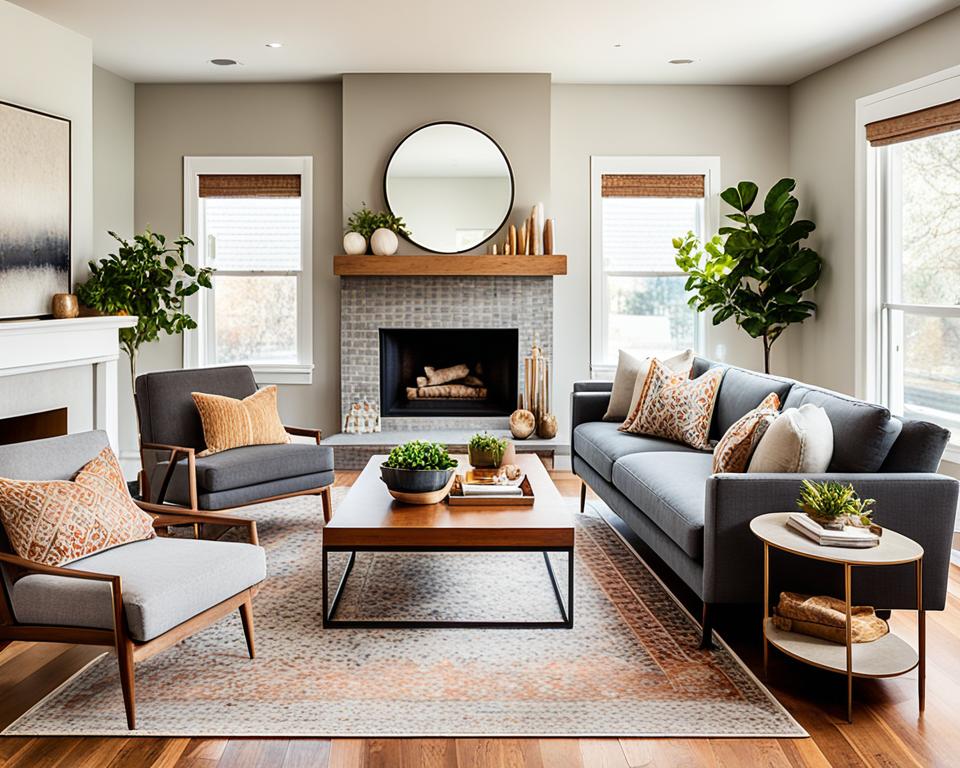
In your pursuit of interior sophistication, draw upon the centuries-old knowledge encapsulated in Persian carpets reviews and embrace the allure that these ancient handcrafted jewels provide. With each rug, you’re not just laying a fixture underfoot; you’re laying the groundwork for a home that echoes with tales of Persian diligence and an aesthetic that has stood the test of time.
Authentic Persian Rug Guide for Novice Collectors
Welcome to the fascinating world of Persian rugs—an arena where history, art, and craftsmanship intertwine to create masterpieces for the discerning decorator. As a novice collector, grasping the essentials of an authentic Persian rug can seem daunting. However, this guide will illuminate your path, equipping you with indispensable Persian rug buying tips to add a touch of Persian heritage to your home confidently.
Delving into these textiles’ subtleties is the key to recognizing their genuine quality. To assist you in your collecting journey, we offer insights that distill years of tradition into understandable advice. By following this authentic Persian rug guide, you will develop a refined eye. It will serve you not just in your first purchase, but as a long-lasting skill in appreciating—and acquiring—pieces of timeless beauty and worth.
As part of your educational journey, consider several critical aspects when examining Persian rugs:
- Knot Count and Craftsmanship: A traditional Persian rug’s value can often be signified by its knot count – a high density typically indicates meticulous hand weaving.
- Materials with a Message: The use of natural materials such as wool, silk, and cotton speaks volumes about a rug’s authenticity and quality.
- Physical Examination: Incorporate tactile assessment by touching the rug’s fibers and inspecting the reverse for unique hand-knotted signatures.
- Color Authenticity: Authentic Persian rugs often feature natural dyes with a subtle variation that synthetic dyes cannot replicate.
By integrating these tips into your buying strategy, you’ll strengthen your position as a knowledgeable collector. Embrace the captivating realm of Persian rugs, understanding the stories woven into each pattern and revel in the craftsmanship passed down through generations. With your newfound expertise, the ideal Persian rug for your collection awaits.
Remember, the acquisition of a Persian rug is not just a home decor enhancement—it’s an investment. By absorbing the wisdom within this authentic Persian rug guide, your selections will reflect both an appreciation for artistry and a nod to historical culture.
How to Maintain and Care for Your Persian Rug
The intrinsic beauty and intricate designs of Persian rugs require a dedicated approach to maintenance and care. Heeding expert handmade Persian rug reviews, you will find that the longevity of these textiles is heavily rooted in the care they receive. Delicate fabrics and dyes call for a systematic regimen to preserve their form and splendor. Below, discover the fundamental cleaning techniques and preservation tips crucial to sustaining the classic allure of your Persian rug.
Cleaning Techniques and Preservation Tips
To keep your Persian rug looking impeccable, regular cleaning is essential. Begin with gentle vacuuming, which will prevent dirt accumulation without stressing the rug fibers. Immediate attention to spills is critical; blot, do not rub, to minimize absorption into the fibers. For persistent or deep stains, seek professional cleaning services that specialize in Persian rugs, ensuring that they use methods conducive to preserving natural fibers and dyes.
To ensure even wear and to maintain the rug’s texture, rotate it periodically. Additionally, keep the rug shielded from prolonged sun exposure to prevent the natural dyes from fading—UV-filtering window treatments can be particularly beneficial in conservation efforts. Embrace these Persian rug care tips to protect your investment and its storied legacy within your home.
Avoiding Common Damaging Practices
There are certain practices that can inadvertently shorten the life of your Persian rug. Over-wetting when attempting to clean the rug yourself is a common mistake—excess moisture can damage the foundation and lead to mold growth. Harsh chemicals and abrasive tools are also detrimental, potentially causing irreparable harm to the delicate materials. Steer clear of these damaging practices to safeguard the handwoven elegance underfoot.
Caring for a Persian rug encompasses more than routine cleaning; it’s an act of preservation that honors the heritage and intricate craftsmanship. By incorporating these care strategies, the narrative embodied in your Persian rug will continue to unfurl in beauty and grace for many years to come.
Unveiling the Mystery Behind Persian Rug Knots
Step into the world of Persian carpets—a realm where each twist and turn of the weaver’s hand contributes to the rug’s grand narrative. In this in-depth Persian carpets reviews, we shall explore the various knot types integral to the durability and valuation of these woven masterpieces. This knowledge is not only fascinating but crucial for anyone participating in a Persian rug comparison before making a purchase.
Knot Types and Their Impacts on Rug Durability
The resilience of a Persian rug is largely influenced by the types of knots used in its creation. The Persian Senneh knot, with its asymmetrical form, allows for intricate details and an elaborate design—a distinctive feature that enriches the rug’s texture and aesthetics. Meanwhile, the Turkish Ghiordes knot presents a symmetrical structure, endowing the rug with robustness and a sturdy feel that promises longevity.
Knot Density and Its Role in Valuation
Knot density, often measured as knots per square inch (KPSI), is pivotal in assessing a Persian rug’s quality. High knot density rugs are not only cherished for their refined texture and detailed patterns but also command a higher value in the marketplace. Here’s a table to help you discern the subtleties:
| Knot Type | Features | Impact on Durability | Influence on Value |
|---|---|---|---|
| Persian Senneh | Asymmetrical, allows detailed designs | Enhances design intricacy while providing decent durability | Highly valued for fine-detail work |
| Turkish Ghiordes | Symmetrical, offers strength | Leads to a sturdy and long-lasting rug | Appreciated for strength, resulting in enduring value |
| Knot Density | Higher knots per square inch (KPSI) | Increased durability and detailed imagery | Typically higher valuation, especially for intricate patterns |
Grasping the significance of these knotted nuances will enhance your understanding and appreciation of Persian carpets, allowing you to make an informed choice rooted in the traditions of Persian craftsmanship.
Persian Rug Review: A Tapestry of Rich History and Art
Embark on a journey through the intricate and storied world of Persian rugs, where each weave carries the weight of history and the touch of artisans’ hands. With durability that withstands the sands of time, natural materials that exude elegance, and intricate patterns that tell countless stories, Persian Rug Review acknowledges the depth of Persian rug ratings and the beauty these masterpieces add to homes around the world.
In the realm of Persian carpets reviews, these rugs are extolled for their enchanting designs that offer a window into a rich cultural past, brought to life in every knot. Imagine the stories they could share—tales of ancient empires, the whispers of the bazaar, and the pride of generations of weavers. Embrace the artistry and legacy that come with owning a Persian rug—a timeless piece of artistry.
Every knot tells a story and every pattern reveals a past—a Persian rug is not just a home accessory but a piece of living history.
With a Persian carpet, you hold a piece of art that’s been patiently handcrafted by skilled artisans who have passed down their knowledge through the ages. As you step onto its lush textures, feel the connection to those ancient hands and honor the dedication poured into every fiber.
As assessed in Persian carpets reviews, the preference for these rugs is not merely a matter of taste but a testament to their superior craftsmanship and enduring appeal. Whether your home is a haven of modernity or a sanctuary of tradition, a Persian rug can bridge worlds, bringing a sense of balance and harmony to your personal space.
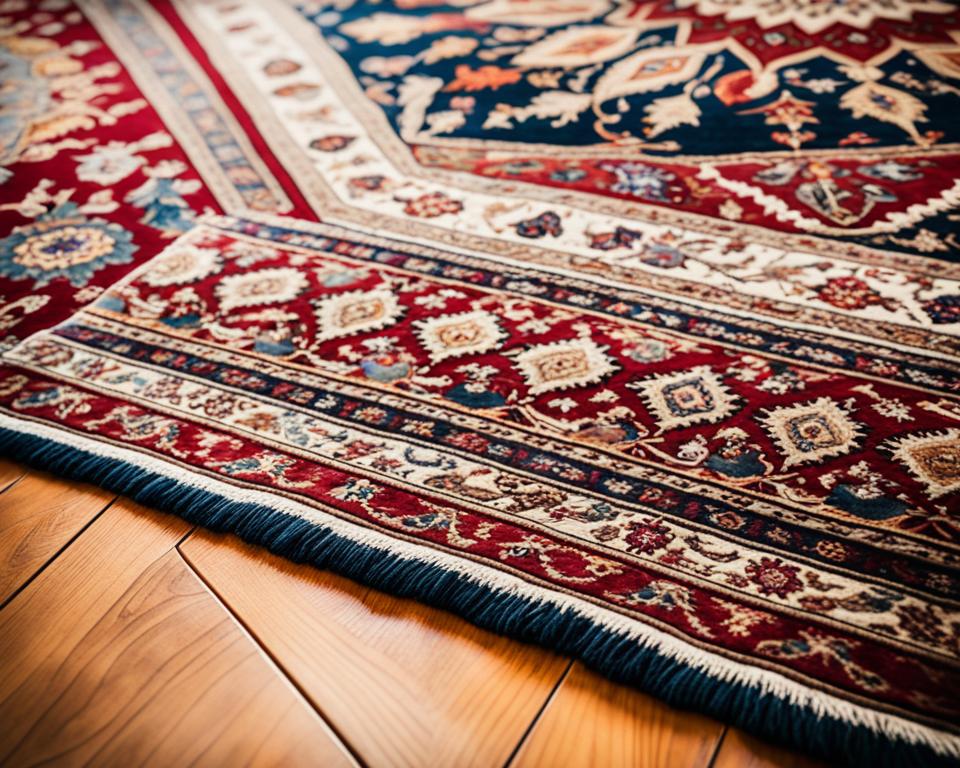
- Gaze upon vibrant dyes, naturally sourced, lending authenticity with their unique variegations.
- Touch the textures, from soft wools to luxurious silks, each chosen for durability and comfort.
- Discover patterns that range from the bold geometric shapes to delicate floral vines, each rooted in history and symbolism.
When you choose from the pantheon of Persian rug reviews, trust that you are selecting not just an addition to your décor but a confluence of mystery, ancient tradition, and unmatched elegance. It is no wonder that discerning homeowners and collectors alike covet the Persian rug’s unparalleled aesthetic—an aesthetic preserved through the passionate retelling of Persian carpets reviews.
Conclusion
As we draw the threads of our journey through the world of Persian rugs to a close, it is evident that these are not simply floor coverings but canvases that showcase a country’s artistic heritage. In our Persian Rug Review, we’ve unraveled the elements that render the Best Persian rugs as investments in both art and history. From the skilled hands that tie each knot to the natural hues brought to life through traditional dyeing methods, every facet of an authentic Persian carpet narrates a story woven through time.
Summarizing the Essence of Authentic Persian Carpets
The essence of authentic Persian carpets lies in their unparalleled craftsmanship, their materials that command regard, and the cultural narratives they eloquently illustrate upon their surfaces. Each piece radiates the legacy of its origins, paying homage to the ancient artistry that continues to influence contemporary aesthetics. These are acquisitions that surpass mere household decor, becoming transformative elements that enrich your living spaces in profound ways.
Your Ultimate Checklist Before Purchasing
Before securing a Persian carpet, arm yourself with a checklist infused with adept Persian rug buying tips. Verify that the rug is meticulously hand-knotted, intricately patterned, and crafted using fibers dyed by natural means. Authenticating the rug’s origin and engaging with reputable dealers will further ensure that your choice is a genuine echo of Persian antiquity. Evaluating elements like knot count, fidelity of patterns, plushness of material, and integrity of color are instrumental actions in acquiring a genuine Persian rug that will be cherished for generations, offering both luxury and legacy.
FAQ
What factors determine the authenticity of a Persian rug?
The authenticity of a Persian rug is determined by its hand-knotted construction, knot count, which should be at least 120 knots per square inch for quality rugs, use of natural materials such as wool, cotton, or silk, and use of natural dyes, that offer vibrant colors with subtle variations. Authenticity can also be assessed by examining the rug’s underside for individual knots and imperfections, which indicate handcrafting.
How can the design and patterns of a Persian rug indicate its origin?
Persian rug designs and patterns vary by region and often include symbolic meanings. Floral patterns could represent nature and life, while geometric patterns might symbolize order and structure. The paisley design might suggest eternity. Regional variations are significant; for instance, Tabriz rugs are known for their teardrop medallions and historical scenes, while other regions have their unique identifiers that allude to their distinct weaving traditions.
Can you elaborate on the legacy of Tabriz rugs within the Persian rug industry?
Tabriz rugs are esteemed within the Persian rug industry for their high knot density and sophisticated design elements, which include elaborate medallions, floral motifs, and occasional scenes of historical significance. These rugs reflect the rich cultural history of Tabriz, one of the oldest weaving centers, and are a testament to the labor-intensive process and meticulous craftsmanship that goes into making an authentic Persian rug.
What is the difference between hand-knotted and machine-made Persian rugs?
Hand-knotted Persian rugs are meticulously crafted, with weavers tying each knot individually, which can be examined by inspecting the rug’s underside where knots should be visible. Machine-made rugs, in contrast, are typically mass-produced using synthetic materials and depict a uniform knotting pattern with a rigid plastic backing, lacking the artisanal quality of hand-knotted rugs.
How do material quality and color affect Persian rug ratings?
Persian rug ratings are significantly affected by material quality, with hand-spun wool being preferred for its hypoallergenic properties and durability, and silk esteemed for its elegance and fine texture. The color’s vibrancy and fastness also contribute to ratings; natural dyes offer a rich palette and longevity, while synthetic dyes are prone to fading and color bleeding.
Are modern touch Persian rugs as appreciated as traditional designs?
Yes, modern touches in Persian rugs are appreciated as they blend age-old weaving techniques with contemporary styles, enabling these traditional crafts to align with current home decor trends. This balance maintains the rugs’ cultural significance and appeals to a broader audience that seeks a mix of tradition and modernity.
What are the unique features of top Persian rug brands?
Top Persian rug brands are distinguished by their unique weaving techniques, region-specific designs, and quality of materials. Notable features may include the intricate patterns of Tabriz rugs, the robust weaves of Heriz rugs, and the famed silk rugs from Qom. Each brand’s heritage and connection to cultural history enhance their reputation and authenticity.
How do you balance cost and quality when purchasing a Persian rug?
Balancing cost and quality involves understanding factors that affect pricing, such as material rarity, knot density, and weaving region reputation. It’s essential to recognize that higher-quality materials and more intricate designs often command higher prices. Consumers should decide on their budgets and preferences, but investing in higher-quality rugs can result in acquiring pieces that last longer and retain or increase in value over time.
What should I look for in handmade Persian rug reviews?
When reading handmade Persian rug reviews, look for commentary on the quality of craftsmanship, material, and dyes used, as well as the individuality of the rug’s designs and patterns. Reviews may also discuss the cultural aspects and the storytelling conveyed through the rug’s symbolism, which adds to its allure and value.
How can I ensure I’m buying an authentic Persian rug?
To ensure you’re buying an authentic Persian rug, verify its hand-knotted construction, the use of natural materials and dyes, and distinctive characteristics like fringes that are extensions of the warp yarns. Check for information about the rug’s origin, seek knowledge on handcrafting imperfections, and buy from reputable rug dealers who can assure the authenticity and quality of their rugs.
How can the type of Persian rug I choose affect its suitability for my home?
The type of Persian rug you choose should match the intended use and aesthetic of your home. For example, Tabriz rugs with high knot density and intricate patterns are suitable for formal spaces, whereas durable, easy-to-maintain Qashqai rugs may be more appropriate for casual, high-traffic areas. Consider the style, color, material, and craftsmanship to determine the best fit for your space.
Why are Persian rugs important to home decor?
Persian rugs are integral to home decor because they add warmth, history, and a global influence to any space. They can transform an ordinary room into an extraordinary one, not only serving as floor coverings but also as expressive conversation pieces that reflect the artistry and cultural narratives of their origins.
What are some essential tips for maintaining and caring for Persian rugs?
Essential tips for maintaining and caring for Persian rugs include regular vacuuming with gentle suction, addressing spills promptly, and seeking professional cleaning services for deep stains. It’s important to avoid harsh chemicals and over-wetting, rotate the rug periodically to ensure even wear, and keep it out of direct sunlight to prevent fading. These practices help preserve the rug’s beauty and longevity.
How do different knot types affect a Persian rug’s durability?
Different knot types affect a Persian rug’s durability and texture. Persian Senneh knots, which are asymmetrical, allow for finer detailed designs. Turkish Ghiordes knots are symmetrical and known for their strength, making them conducive to a durable rug structure. The chosen knot type will thus contribute to the overall feel and lifespan of the rug.
How do I evaluate the quality and worth of a Persian rug?
Evaluate the quality and worth of a Persian rug by inspecting the knot density; higher knots per square inch typically indicate better quality and finer detail, which translates to higher value. Also, assess the material and dye quality, the evenness of the weave, the balance of the pattern, and the overall aesthetic appeal. Consulting with experts and referencing the reputation of the rug’s region of origin can also provide insights into its valuation.
